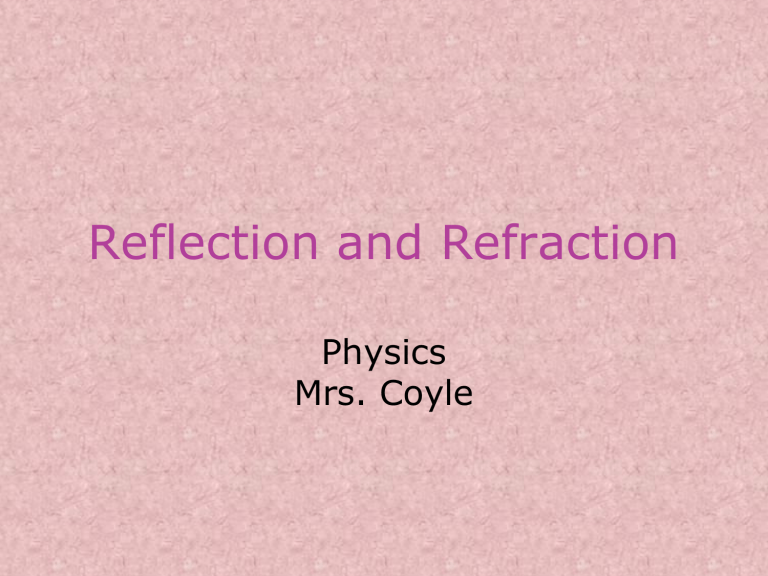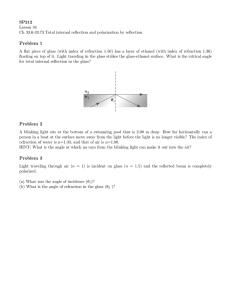
Reflection and Refraction Physics Mrs. Coyle Reflection When a wave reaches a boundary it is: – Partially reflected (bounces off surface) – Partially transmitted through surface. Law of Reflection Angle of incidence = Angle of reflection Note • The angle of incidence is formed between the incident ray and the normal. • The angle of reflection is formed between the reflected ray and the normal. Specular Reflection • A reflection produced by a smooth surface. Diffuse Reflection • Reflection from a rough surface. http://micro.magnet.fsu.edu/primer/java/reflection/specular/specularjavafigure1.jpg Reflection from a Plane Mirror di=do hi=ho Type of Image • Real or Virtual • Enlarged or Reduced • Erect or Inverted What is the minimum mirror height required for a person to see their full self in the mirror? Hint: Compare AB to CD C A B D Refraction • When a wave crosses a boundary between Medium 1 and Medium 2, the wave changes direction because it changes velocity. • Frequency remains constant. • Velocity changes as a result of wavelength change. • Simulations • http://www3.interscience.wiley.com:8100/legacy/college/halliday/0471320 005/simulations6e/index.htm • http://www.walter-fendt.de/ph14e/refraction.htm ******* Refraction Example Incident Ray Less Rigid Medium Refracted Ray More Rigid Medium Refracted ray bends towards the normal. Index of Refraction, n n=c/v • c : the speed of light in a vacuum, 3 x 108 m/sec • v : speed of light in the medium. • n : medium's index of refraction • n>1 (Why?) Indices of Refraction Vacuum Air Water Ethanol Crown glass Quartz Diamond 1.00 1.0003 1.33 1.36 1.52 1.52 2.42 Note • The speed of light has a lower speed in a more optically dense medium. Problem • What is the speed of light in quartz? • Answer: 1.97 x 10 8 m/s Snell’s Law • n1 sin q1 = n2 sin q2 Note When the incident ray travels from a less optically dense medium (low n) to a more optically dense medium (higher n) then the refracted ray bends towards the normal. Problem • What is the angle of refraction when a ray from air with an angle of incidence of 25 o is incident to water? • Draw the ray diagram. • Answer: 18.5 o Total Internal Reflection • Can occur when ray goes from higher n to lower n. • Above a Critical angle (of incidence) the ray is reflected, not refracted • http://www.walter-fendt.de/ph14e/refraction.htm • For problems, set the angle of refraction to 90, and solve for critical angle Problem • Find the critical angle for a light ray that is incident from water to air. • Answer: 48.8 o Dispersion • The index of refraction of glass is different for the colors that make up white light because the speed of light is slightly different in glass for each frequency of light. (In vacuum all colors have speed c=3x108m/s.) Problem The index of refraction for crown glass for red light is 1.514. What is the speed of red light in crown glass? Answer: 1.98 x 10 8 m/s Mirage http://www.warrenwilson.edu/~physics/PhysPhotOfWeek/2007PPOW/20070921RoadMirage/IMG_ 1444MirageCrop500.jpg Mirage Total internal reflection occurs because hot air has a lower n, than cold air. http://www.warrenwilson.edu/~physics/PhysPhotOfWeek/2007PPOW/20070921RoadMirage/index.html


